Astronaut Journal Entry - Alarms
Astronaut Journal Entry - Alarms
Currently, six humans are living and working on the International Space Station, which orbits 250 miles above our planet at 17,500mph. Below you will find a real journal entry, written in space, by NASA astronaut Scott Tingle.
To read more entires from this series, visit our Space Blogs on Tumblr.

The smoke detectors have been setting off alarms. This happens routinely due to dust circulating in the modules, but every alarm is taken seriously. This is the third time that the alarm has sounded while I was using the Waste & Hygiene Compartment (toilet). I am starting to think that my actions are causing the alarms…. maybe I should change my diet?
Find more ‘Captain’s Log’ entries HERE.
Follow NASA astronaut Scott Tingle on Instagram and Twitter.
Make sure to follow us on Tumblr for your regular dose of space: http://nasa.tumblr.com.
More Posts from Nasa and Others
What was the hardest part in training to go to space?
One of the most challenging parts of space training was learning how to use the space suit. We weigh over 400 pounds in the space suit, and since it is pressurized, each movement of your hands is like working against an exercise ball. Since the suit needs to be quite bulky in order to protect us from the environment of space (vacuum, radiation, micrometeoroids, extreme temperature) while doing a spacewalk, it makes body movements a bit awkward. Dexterity is quite compromised with the bulky gloves as well. Although it is challenging, however, it is likely also the most rewarding, because, well, you are in a SPACE SUIT!!! Hopefully I’ll get to do a spacewalk and look down on the our planet from above on a mission to the International Space Station in a few years.
Crab Nebula in technicolor! This new composite view combines data from five different telescopes, showing the celestial object in multiple kinds of light.
The video starts with a composite image of the Crab Nebula, a supernova remnant that was assembled by combining data from five telescopes spanning nearly the entire breadth of the electromagnetic spectrum: the Very Large Array, the Spitzer Space Telescope, the Hubble Space Telescope, the XMM-Newton Observatory, and the Chandra X-ray Observatory.
It then dissolves to the red-colored radio-light view that shows how a neutron star’s fierce “wind” of charged particles from the central neutron star energized the nebula, causing it to emit the radio waves.
The yellow-colored infrared image includes the glow of dust particles absorbing ultraviolet and visible light.
The green-colored Hubble visible-light image offers a very sharp view of hot filamentary structures that permeate this nebula.
The blue-colored ultraviolet image and the purple-colored X-ray image shows the effect of an energetic cloud of electrons driven by a rapidly rotating neutron star at the center of the nebula.
Make sure to follow us on Tumblr for your regular dose of space: http://nasa.tumblr.com
How can people in the US help the space program?
I used to think STEM was a buzzword, but actually in the United States we do need more students entering into the Science, Technology, Engineering, and Math fields. By doing this, they can help develop technologies to help get humans further and further into deep space and discover new things about the universe.
How Do Space Telescopes Break Down Light?
Space telescopes like Hubble and our upcoming James Webb Space Telescope use light not only to create images, but can also break light down into individual colors (or wavelengths). Studying light this way can give us a lot of detail about the object that emitted that light. For example, studying the components of the light from exoplanets can tell us about its atmosphere’s color, chemical makeup, and temperature. How does this work?
Remember the primary colors you learned about in elementary school?
Those colors are known as the pigment or subtractive colors. Every other color is some combination of the primary colors: red, yellow, and blue.

Light also has its own primary colors, and they work in a similar way. These colors are known as additive or light colors.
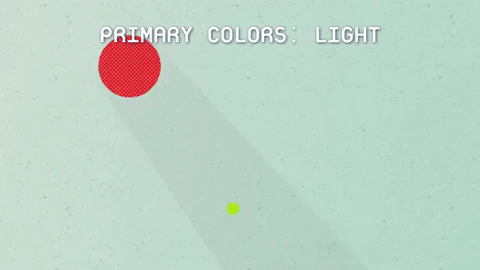
TVs make use of light’s colors to create the pictures we see. Each pixel of a TV screen contains some amount of red, green and blue light. The amount of each light determines the overall color of the pixel. So, each color on the TV comes from a combination of the primary colors of light: red, green and blue.

Space telescope images of celestial objects are also a combination of the colors of light.
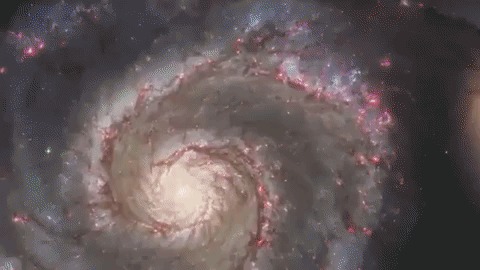
Every pixel that is collected can be broken down into its base colors. To learn even more, astronomers break the red, green and blue light down into even smaller sections called wavelengths.
This breakdown is called a spectrum.
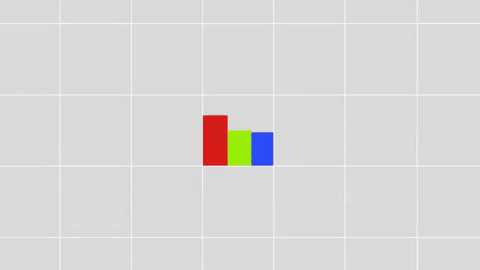
With the right technology, every pixel of light can also be measured as a spectrum.

Images show us the big picture, while a spectrum reveals finer details. Astronomers use spectra to learn things like what molecules are in planet atmospheres and distant galaxies.
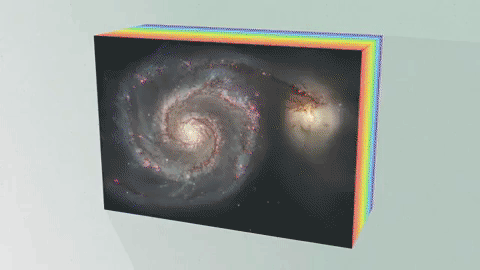
An Integral Field Unit, or IFU, is a special tool on the James Webb Space Telescope that captures images and spectra at the same time.
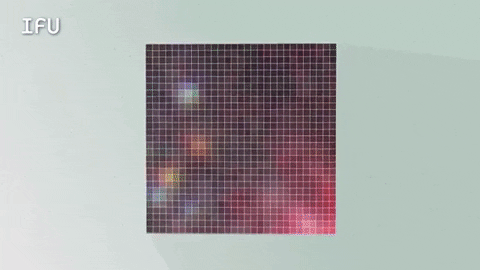
The IFU creates a unique spectrum for each pixel of the image the telescope is capturing, providing scientists with an enormous amount of valuable, detailed data. So, with an IFU we can get an image, many spectra and a better understanding of our universe.
Watch the full video where this method of learning about planetary atmospheres is explained:
The James Webb Space Telescope is our upcoming infrared space observatory, which will launch in 2021. It will spy the first galaxies that formed in the universe and shed light on how galaxies evolve, how stars and planetary systems are born and tell us about potentially habitable planets around other stars.
To learn more about NASA’s James Webb Space Telescope, visit the website, or follow the mission on Facebook, Twitter and Instagram.
Text and graphics credit: Space Telescope Science Institute
Make sure to follow us on Tumblr for your regular dose of space: http://nasa.tumblr.com.
What’s Up for September 2016

We won’t have a solar eclipse until Aug. 21, 2017, but observers in central Africa will see an annular eclipse, where the moon covers most but not all of the sun, on Sept. 1. Observers always need to use safe solar eclipse glasses or filters on telescopes, binoculars and cameras.

Also this month, there are two minor meteor showers, both with about 5 swift and bright meteors per hour at their peak, which will be near dawn. The first is the Aurigid shower on Sept. 1. The new moon on the first means the sky will be nice and dark for the Aurigids.

The second shower is the Epsilon Perseids on Sept. 9. The first quarter moon sets on the 9th at midnight, just in time for the best viewing of the Perseids.

There are many nice pair-ups between the moon and planets this month. You can see the moon between Venus and Jupiter on Sept. 2, and above Venus on the 3rd, right after sunset low on the West-Southwest horizon. On the 15th the nearly full moon pairs up with Neptune, two weeks after its opposition, when the 8th planet is closest to Earth in its orbit around the sun.
Watch the full September “What’s Up” video for more:
Make sure to follow us on Tumblr for your regular dose of space: http://nasa.tumblr.com.
Solar System: Things to Know
Help us find the most interesting spots to image on Jupiter, learn how Hubble is helping the Voyager craft find their way and more!
1. Calling All Citizen Scientists!

Join the Mission Juno virtual imaging team by helping us to determine the best locations in Jupiter's atmosphere that JunoCam will capture. Voting is open January 19-23, 2017. Visit www.missionjuno.swri.edu/junocam for more information about JunoCam voting.
2. Leading the Way

Our Hubble Space Telescope is providing a road map for the two Voyager spacecraft as they hurtle through unexplored territory on their trip beyond our solar system. Along the way, the Voyager craft are measuring the interstellar medium, the mysterious environment between stars. Hubble is measuring the material along the probes' future trajectories and even after the Voyagers run out of electrical power and are unable to send back new data, which may happen in about a decade, astronomers can use Hubble observations to characterize the environment of through which these silent ambassadors will glide.
3. Explorers Wanted

Mars needs YOU! In the future, Mars will need all kinds of explorers, farmers, surveyors, teachers . . . but most of all YOU! Join us on the Journey to Mars as we explore with robots and send humans there one day. Download a Mars poster that speaks to you. Be an explorer!
4. Tracking Every Sol

Each sol, or Martian day, the Mars Curiosity Team tracks the rover’s progress. And you can track them too at: http://mars.nasa.gov/msl/mission/mars-rover-curiosity-mission-updates/.
5. Happy 425th birthday, Pierre Gassendi

January 22 is the 425th birthday of Pierre Gassendi, French philosopher, priest, scientist, astronomer, mathematician and an active observational scientist. He was the first to publish data on the 1631 transit of Mercury. The Lunar Crater Gassendi is named for him.
Discover the full list of 10 things to know about our solar system this week HERE.
Make sure to follow us on Tumblr for your regular dose of space: http://nasa.tumblr.com
Things That Go Bump in the Gamma Rays
Some people watch scary movies because they like being startled. A bad guy jumps out from around a corner! A monster emerges from the shadows! Scientists experience surprises all the time, but they’re usually more excited than scared. Sometimes theories foreshadow new findings — like when there’s a dramatic swell in the movie soundtrack — but often, discoveries are truly unexpected.

Scientists working with the Fermi Gamma-Ray Space Telescope have been jumping to study mysterious bumps in the gamma rays for a decade now. Gamma rays are the highest-energy form of light. Invisible to human eyes, they’re created by some of the most powerful and unusual events and objects in the universe. In celebration of Halloween, here are a few creepy gamma-ray findings from Fermi’s catalog.

Stellar Graveyards
If you were to walk through a cemetery at night, you’d expect to trip over headstones or grave markers. Maybe you’d worry about running into a ghost. If you could explore the stellar gravesite created when a star explodes as a supernova, you’d find a cloud of debris expanding into interstellar space. Some of the chemical elements in that debris, like gold and platinum, go on to create new stars and planets! Fermi found that supernova remnants IC 443 and W44 also accelerate mysterious cosmic rays, high-energy particles moving at nearly the speed of light. As the shockwave of the supernova expands, particles escape its magnetic field and interact with non-cosmic-ray particles to produce gamma rays.

Ghost Particles
But the sources of cosmic rays aren’t the only particle mysteries Fermi studies. Just this July, Fermi teamed up with the IceCube Neutrino Observatory in Antarctica to discover the first source of neutrinos outside our galactic neighborhood. Neutrinos are particles that weigh almost nothing and rarely interact with anything. Around a trillion of them pass through you every second, ghost-like, without you noticing and then continue on their way. (But don’t worry, like a friendly ghost, they don’t harm you!) Fermi traced the neutrino IceCube detected back to a supermassive black hole in a distant galaxy. By the time it reached Earth, it had traveled for 3.7 billion years at almost the speed of light!

Black Widow Pulsars
Black widows and redbacks are species of spiders with a reputation for devouring their partners. Astronomers have discovered two types of star systems that behave in a similar way. Sometimes when a star explodes as a supernova, it collapses back into a rapidly spinning, incredibly dense star called a pulsar. If there’s a lighter star nearby, it can get stuck in a close orbit with the pulsar, which blasts it with gamma rays, magnetic fields and intense winds of energetic particles. All these combine to blow clouds of material off the low-mass star. Eventually, the pulsar can eat away at its companion entirely.

Dark Matter
What’s scarier than a good unsolved mystery? Dark matter is a little-understood substance that makes up most of the matter in the universe. The stuff that we can see — stars, people, haunted houses, candy — is made up of normal matter. But our surveys of the cosmos tell us there’s not enough normal matter to keep things working the way they do. There must be another type of matter out there holding everything together. One of Fermi’s jobs is to help scientists narrow down the search for dark matter. Last year, researchers noticed that most of the gamma rays coming from the Andromeda galaxy are confined to its center instead of being spread throughout. One possible explanation is that accumulated dark matter at the center of the galaxy is emitting gamma rays!

Fermi has helped us learn a lot about the gamma-ray universe over the last 10 years. Learn more about its accomplishments and the other mysteries it’s working to solve. What other surprises are waiting out among the stars?
Make sure to follow us on Tumblr for your regular dose of space: http://nasa.tumblr.com.
Spacewalk Recap Told in GIFs
Friday, Oct. 20, NASA astronauts Randy Bresnik and Joe Acaba ventured outside the International Space Station for a 6 hour and 49 minute spacewalk. Just like you make improvements to your home on Earth, astronauts living in space periodically go outside the space station to make updates on their orbiting home.
During this spacewalk, they did a lot! Here’s a recap of their day told in GIFs…
All spacewalks begin inside the space station. Astronauts Paolo Nespoli and Mark Vande Hei helped each spacewalker put on their suit, known as an Extravehicular Mobility Unit (EMU).

They then enter an airlock and regulate the pressure so that they can enter the vacuum of space safely. If they did not regulate the pressure safely, the astronauts could experience something referred to as “the bends” – similar to scuba divers.
Once the two astronauts exited the airlock and were outside the space station, they went to their respective work stations.

Bresnik replaced a failed fuse on the end of the Dextre robotic arm extension, which helps capture visiting vehicles.

During that time, Acaba set up a portable foot restraint to help him get in the right position to install a new camera.

While he was getting set up, he realized that there was unexpected wearing on one of his safety tethers. Astronauts have multiple safety mechanisms for spacewalking, including a “jet pack” on their spacesuit. That way, in the unlikely instance they become untethered from the station, the are able to propel back to safety.

Bresnik was a great teammate and brought Acaba a spare safety tether to use.

Once Acaba secured himself in the foot restraint that was attached to the end of the station’s robotic arm, he was maneuvered into place to install a new HD camera. Who was moving the arm? Astronauts inside the station were carefully moving it into place!
And, ta da! Below you can see one of the first views from the new enhanced HD camera…(sorry, not a GIF).

After Acaba installed the new HD camera, he repaired the camera system on the end of the robotic arm’s hand. This ensures that the hand can see the vehicles that it’s capturing.

Bresnik, completed all of his planned tasks and moved on to a few “get ahead” tasks. He first started removing extra thermal insulation straps around some spare pumps. This will allow easier access to these spare parts if and when they’re needed in the future.

He then worked to install a new handle on the outside of space station. That’s a space drill in the above GIF.

After Acaba finished working on the robotic arm’s camera, he began greasing bearings on the new latching end effector (the arm’s “hand”), which was just installed on Oct. 5.

The duo completed all planned spacewalk tasks, cleaned up their work stations and headed back to the station’s airlock.

Once safely inside the airlock and pressure was restored to the proper levels, the duo was greeted by the crew onboard.

They took images of their spacesuits to document any possible tears, rips or stains, and took them off.

Coverage ended at 2:36 p.m. EDT after 6 hours and 49 minutes. We hope the pair was able to grab some dinner and take a break!
You can watch the entire spacewalk HERE, or follow @Space_Station on Twitter and Instagram for regular updates on the orbiting laboratory.
Make sure to follow us on Tumblr for your regular dose of space: http://nasa.tumblr.com.
Celebrate Earth Day with NASA

"We came all this way to explore the Moon, and the most important thing is that we discovered the Earth." - Apollo 8 astronaut Bill Anders
On Dec. 24, 1968, Anders snapped this iconic photo of "Earthrise" during the historic Apollo 8 mission. As he and fellow astronauts Frank Borman and Jim Lovell became the first humans to orbit the Moon, they witnessed Earth rising over the Moon's horizon. The image helped spark the first #EarthDay on April 22, 1970.
Anders sat down with Dr. Kate Calvin, our chief scientist and senior climate advisor, to chat about the photo, and NASA’s role in studying our home.
Make sure to follow us on Tumblr for your regular dose of space!
Hii! I'm unsure if you've been asked this before, but I'd like to give it a shot anyway. What's the greatest legacy you hope to leave to the future generations? Whether it's one of the things you've accomplished already or are hoping to accomplish yet. Thank you very much!
-
 sweetnature38 liked this · 4 years ago
sweetnature38 liked this · 4 years ago
Explore the universe and discover our home planet with the official NASA Tumblr account
1K posts